Catan: Cities & Knights, formerly The Cities and Knights of Catan, is an expansion to the board game The Settlers of Catan for three to four players. It contains features taken from The Settlers of Catan, with emphasis on city development and the use of knights, which are used as a method of attacking other players as well as helping opponents defend Catan against a common foe. Cities & Knights can also be combined with the Catan: Seafarers expansion or with Catan: Traders & Barbarians scenarios.

Sid Meier's Civilization III is the third installment of the Sid Meier's Civilization turn-based strategy video game series. It was released in 2001, and followed by Civilization IV. Unlike the original game, Civilization III was not designed by Sid Meier, but by Jeff Briggs, a game designer, and Soren Johnson, a game programmer.
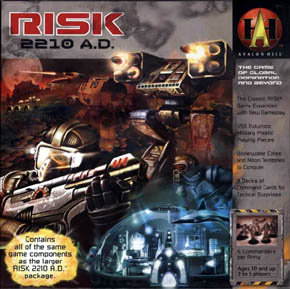
Risk 2210 A.D. is a 2–5 player board game by Avalon Hill that is a futuristic variant of the classic board game Risk. Risk 2210 A.D. was designed by Rob Daviau and Craig Van Ness and first released in 2001. In 2002, it won the Origins Award for "Best Science Fiction or Fantasy Board Game of 2001".
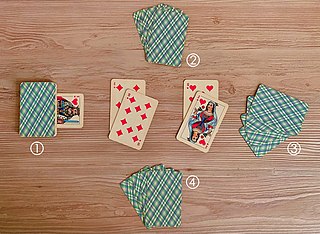
Durak is a traditional Russian card game that is popular in many post-Soviet states. It is Russia's most popular card game, having displaced Preferans. It has since become known in other parts of the world. The objective of the game is to shed all one's cards when there are no more cards left in the deck. At the end of the game, the last player with cards in their hand is the durak or 'fool'.

A Game of Thrones: The Card Game is an out-of-print collectible card game produced by Fantasy Flight Games. It is based on A Song of Ice and Fire, a series of novels written by George R. R. Martin. The first set was Westeros Edition and was released in August 2002. It has since won two Origins Awards. The game's primary designer is Eric Lang, the lead developer is Nate French, with Damon Stone serving as associate designer.

Mare Nostrum is a board game for 3 to 5 players, designed by Serge Laget and published in 2003 by Eurogames. It was also the name of a 1983 board game in the Fronte Mare series.

Alhambra is a 2003 tile-based German-style board game designed by Dirk Henn. It was originally published in Germany by Queen Games in a language-interdependent version; an English-specific version was released in North America by the now-defunct Überplay. The game is a Muslim-themed update, set during the construction of the Alhambra palace in 14th century Granada, of the 1998 stock trading board game Stimmt So!, which in turn was an update of the 1992 mafia influence board game Al Capone; the original version was subsequently released as Alhambra: The Card Game. Upon its release, Alhambra won numerous awards, including the Spiel des Jahres award. Its success has led to the release of numerous expansion packs and spin-off games, and is becoming Queen Games' flagship franchise.
The Universal Fighting System (UFS), rebranded as UniVersus in 2021, is a collectible card game designed by UVS Games. Games of UFS represent a fight between two characters in hand-to-hand combat. Characters are drawn from original properties as well as a number of licensed ones, such as Mega Man, Street Fighter, The King of Fighters XIII and Darkstalkers. The sets are cross-compatible – cards from multiple licenses can be included in the same deck, and characters from different universes may face each other in a match.
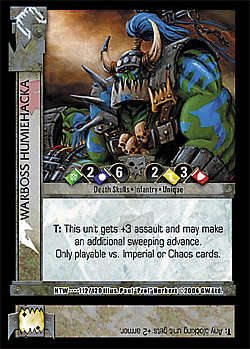
Dark Millennium is an out-of-print collectible card game. It's the successor to the Horus Heresy and set in the fictional Warhammer 40,000 universe. The base card set was launched in October 2005 by Sabertooth Games.
StarCraft: The Board Game, published by Fantasy Flight Games, is a game inspired by the 1998 computer game StarCraft. Players take control of the three distinctive races featured in the video games, the Terrans, the Protoss, or the Zerg, to engage in battle across multiple worlds in order to achieve victory. Each of the three races features a fairly different playing style. A prototype of the game was shown in BlizzCon 2007, with pre-release copies sold at Gen Con 2007 and Penny Arcade Expo 2007. It was publicly released in October 2007.

'Grave Robbers From Outer Space' is an open source collectible card game originally designed by Stephen Tassie and currently published by Steve Caruso under the stewardship of The Academy of Resurrected Games and Holdings (ARGH).
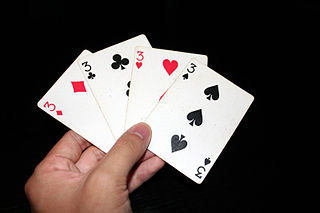
Contract rummy is a Rummy card game, based on gin rummy played by 3 to 8 players. It appeared in the United States during the Second World War. The game is also known as Combination rummy, Deuces Wild Rummy and Joker rummy, and a proprietary version of the game called Phase 10 was published in 1982.

Marvel Trading Card Game is a video game for the Nintendo DS, Windows, and PlayStation Portable. It was developed by Vicious Cycle Software and 1st Playable Productions and published by Konami. The game is based on Upper Deck Entertainment's Marvel Comics-based collectible card game, and was released across all three platforms in several regions in 2007.
Card advantage is a term used in collectible card game strategy to describe the state of one player having access to more cards than another player, usually by drawing more cards through in-game effects to increase the size of their hand. Although it applies to several collectible card games, the concept was first described early in the evolution of Magic: The Gathering strategy, where many early decks relied on a player drawing more cards than their opponent, and then using this advantage to play more cards and advance their position faster than their opponent. By 2007 it was recognized as one of the most important indicators of who is ahead in a game and has been utilized in the development of strategy for nearly every collectible card game created.
Star Wars PocketModel Trading Card Game is an out-of-print tabletop game manufactured by WizKids, Inc. that debuted in 2007, based on the Star Wars universe. The game was designed by Mike Elliott and Ethan Pasternack.

Age of Mythology: The Boardgame is a board game created by Glenn Drover based on the video game Age of Mythology. It was released in 2003 by Eagle Games. Up to four players may play the game, but extra parts may be purchased from Eagle Games to allow eight players to play.
The rules of Magic: The Gathering were originally developed by the game's creator, Richard Garfield, and accompanied the first version of the game in 1993. The rules of Magic have been changed frequently over the years by the manufacturer, Wizards of the Coast, mostly in minor ways. However, major rules overhauls have also been done a few times.

7 Wonders is a board game created by Antoine Bauza in 2010 and originally published by Repos Production. Three decks of cards featuring images of historical civilizations, armed conflicts, and commercial activity are used in the card drafting game 7 Wonders. The game received critical success upon its release, and won numerous awards, including the inaugural Kennerspiel des Jahres connoisseurs' award in 2011.
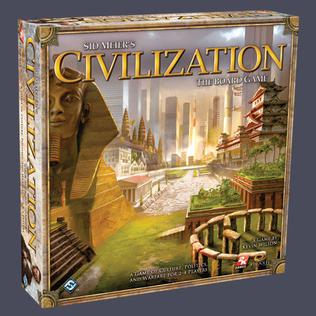
Sid Meier's Civilization: The Board Game is a 2010 board game created by Kevin Wilson based on the Sid Meier's Civilization series of video games and published by Fantasy Flight Games. While the previous board game based on Sid Meier's Civilization, published by Eagle Games in 2002, was based on Civilization III, the 2010 version takes its primary inspiration from Civilization IV. Its expansions, Fame and Fortune and Wisdom and Warfare, also began to incorporate concepts derived from Civilization V.

Star Realms is a card-based deck-building science-fiction tabletop game, designed by Rob Dougherty and Darwin Kastle and published in 2014 by Wise Wizard Games. The game started out as a Kickstarter campaign in 2013. The goal of Star Realms is to destroy opponents by purchasing cards using "trade" points and using these cards to attack an opponent's "authority" using "combat" points. The game takes place in a distant future where different races compete to gain resources, trade and outmaneuver each other in a race to become ruler of the galaxy.













